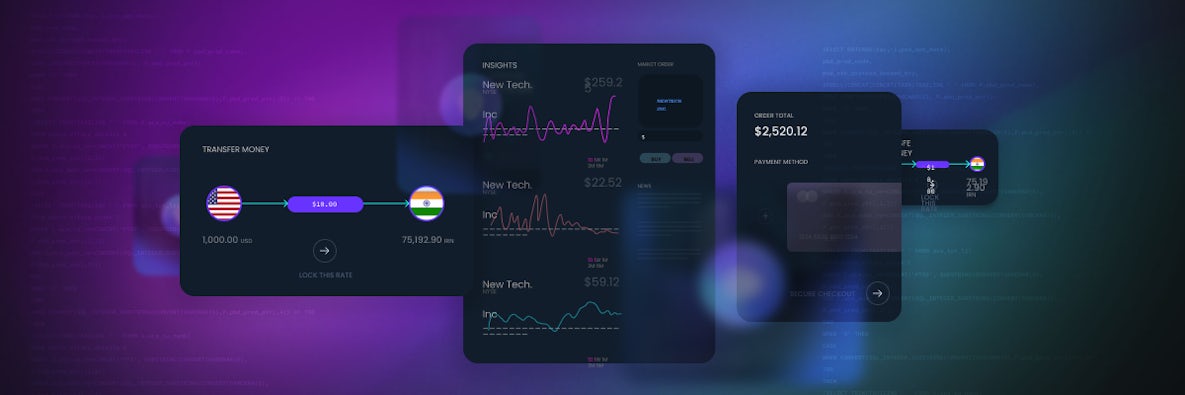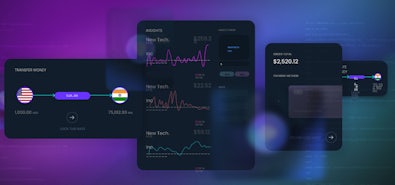
Modern fintech apps like Betterment and Robinhood push the limits of what consumers expect from banking apps. One of their biggest competitive advantages is that they can support real-time decision-making and transaction processing, providing users with instant decisions, personalized experiences, and feature-rich applications.
To keep up, banks and financial services organizations need to embrace digital transformations that enable them to innovate around transaction services. These services can include dynamic pricing, hyper-personalized content, real-time business process optimization, and fraud detection.
Financial services organizations have a wealth of transaction data. By finding an efficient way to gather, store, automate, and analyze this data, they can gain invaluable customer insights and build solutions that are miles ahead of the competition. This is where cloud-native infrastructures come in – making data more accessible and providing timely insights to enable automation and guide informed decision-making. Banks need to adopt these modern, cloud-native data platforms, replacing the likes of Oracle, IBM DB2, NoSQL, and other legacy systems.
Cloud-native = containers + microservices
Another key benefit of cloud-native architecture for financial services organizations is that applications are distributed and made up of loosely coupled microservices. This provides low latency, even when operating at high-volumes, by moving the data closer to the source. Distributed applications also provide better uptime since data stored in a centralized location is vulnerable to outages or attacks and makes it easier for banks to add new state-of-the-art capabilities and services.
Cloud native architecture is designed to integrate seamlessly with one or more private, public, or hybrid cloud platforms. It uses modern application development principles and tools, like containers and microservices, to build portable, scalable applications. By their very definition, containers provide a simple way for processes and applications to be bundled and used throughout the entire application life cycle – from development to test to production.
Kubernetes, the container orchestrator that is often synonymous with cloud-native deployments, has been a popular choice for fintech organizations like Nubank and Square. Even larger, more traditional banks, like Ant Financial, BlackRock, and Capital One, have moved off of or integrated their legacy software with Kubernetes and other open source tools in the cloud-native community.
By building a cloud-native infrastructure, financial services organizations can create a dynamic environment composed of independent processes that all work together seamlessly and make it easy to add new features. Beyond transaction services, cloud-native architectures are driving innovation in areas like data science, IoT, and edge computing.
What to look for in your cloud-native database: performance, flexibility, scale, and Kubernetes
Banks and financial services organizations have found, however, that moving to a cloud-native architecture can introduce new challenges. Legacy data platforms were not designed to handle the complexity of distributed environments or large numbers of services and often break down when stretched.
To fill this gap, financial services organizations should adopt a flexible database solution that provides easy access to the transaction data needed to add new innovative and personalized services. It should be for the cloud built from the ground up to take advantage of the scale and resiliency yet capable of being deployed on-premises or across hybrid or multi-cloud environments. It should also be easy to add new nodes for scale and automatically rebalance and replicate data throughout a distrusted system.
Some of the critical database features that financial organizations should look for include:
- ACID compliance and consistent transactions: A database needs to guarantee ACID (atomicity, consistency, isolation, and durability) compliance to ensure the validity of transaction data. No single node should be responsible for handling all data affecting a transaction.
- Built for Kubernetes: A modern database should be architected to integrate with Kubernetes and other cloud-native tools and deliver scalability and resilience in a Kubernetes environment.
- Compatibility: A database should fit in with an organization’s existing SQL expertise and be compatible with its current applications. It should also align with the development approaches used by the organization.
- Support for multi-national customers: Geo-partitioning allows organizations to determine where distributed data resides, keeping it close to the source to reduce latency. It also helps ensure compliance with data protection and privacy laws.
By combining these features, banks and financial services organizations can quickly and efficiently create new transaction services and personalized features.
Finding a partner in Cockroach Labs
One such database is CockroachDB, the cloud-native, distributed SQL database that provides next-level consistency, ultra-resilience, data locality, and massive scale to modern cloud applications.
But organizations need to think beyond just features. As with other tools and technologies in the cloud-native space, financial services organizations can look for free and open source software (FOSS) solutions and build around them. These require a substantial time investment and a team with deep expertise to make them run in production in a high-stakes enterprise environment. The simpler solution is to partner with a solutions provider, like CockroachLabs, that brings both the technology and deep industry expertise.
“At JPMorgan Chase… CockroachDB provides us with a modern database platform that has accelerated our momentum toward cloud-first, resilient infrastructure and a new class of modern financial applications,” said George Sherman, Global Technology Infrastructure CIO at JPMorgan Chase. Cockroach Labs was inducted into the JPMorgan Chase Hall of Innovation to help the financial services leader build next-generation applications and infrastructure.
For a real-world example, an American financial data firm that was frustrated by its legacy Oracle database architecture turned to CockroachDB to consolidate its several databases worldwide into a single platform and migrate its applications to the cloud. Now, the database is capable of deploying across both on-premise machines and cloud data centers. The firm also took advantage of geo-partitioning to replicate data across its regions and minimize latency for its identity and access management system. It plans to migrate more and add brand new apps to its CockroachDB deployment.
Additionally, one of the largest financial software companies in the U.S adopted CockroachDB when it needed a new database solution for its customer identity access management (CIAM). It decided to deploy CockroachDB to its AWS regions for consistency, resilience against outages, and high performance across multiple regions. The company was able to improve its customer login experience by moving off of Oracle GoldenGate. Now, because of its distributed nature, it only takes about 280 milliseconds to achieve login authorization no matter where the customer is located.
CockroachDB delivers distributed SQL and combines the familiarity of relational data with elastic scale and bulletproof resilience. CockroachDB is:
- Simple to scale
- Architected to handle unpredictability and survive failures
- ACID-compliant
- Cloud-native and designed for Kubernetes
- The only database solution that offers geo-partitioning for multi-region deployments
Many global banks, financial services organizations, and fintech companies have already adopted CockroachDB for their transaction-based workloads. Download the eBook ‘How Financial Service Companies Can Successfully Migrate Critical Applications to the Cloud’ to learn more.


